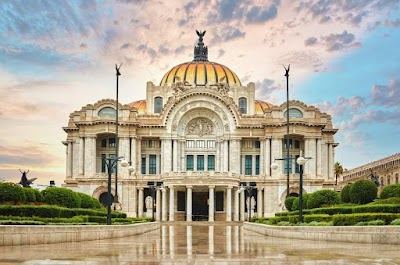Zócalo (Plaza de la Constitución)
Overview
Zócalo: The Heart of Ciudad de México
Zócalo, also known as Plaza de la Constitución, is the vibrant heart and soul of Ciudad de México. This expansive square, one of the largest city squares in the world, is steeped in rich history and cultural significance, making it a must-visit destination for travelers.
The origins of Zócalo date back to the times of the Aztec Empire, serving as the city's primary ceremonial hub. Following the Spanish conquest led by Hernán Cortés in 1521, the Aztec temples were destroyed, paving the way for the construction of the iconic Metropolitan Cathedral and the Viceroy's Palace, both of which continue to define the square's skyline today.
Construction of Zócalo as we know it began in 1524, shortly after the conquest. The design was heavily influenced by Spanish architectural styles, featuring expansive open spaces meant for public gatherings and ceremonies. This grand space was intended to symbolize the power of the Spanish Crown and facilitate the new social and religious order. Over the centuries, the square was extended and refined, adapting to the needs of its ever-evolving society.
In the 19th century, Mexico—formerly known as Nueva España—gained independence from Spain, and Zócalo transformed into a symbol of national pride and identity. Modifications were made to reflect this newfound independence, and the square was officially named Plaza de la Constitución to honor the country's constitution.
An interesting anecdote about the square is the project to erect a monument at its center. While plans were made, only the base of the statue, known as "El Zócalo," was completed. This unfinished base ultimately lent its name to the entire plaza, leading to the common usage of the name Zócalo.
Throughout the 20th century, Zócalo saw several redevelopment efforts to accommodate modern infrastructure and urban growth. The square was paved, and surrounding buildings were updated to serve the growing population. It also became a central stage for political and social events, hosting everything from presidential inaugurations to protests and celebrations.
Surrounding the Zócalo are some of the most significant buildings in Ciudad de México. The Metropolitan Cathedral, one of the largest and oldest cathedrals in the world, showcases an impressive blend of baroque and neoclassical architectural styles. Next to it, the Templo Mayor, the ruins of an ancient Aztec temple, offer a fascinating glimpse into the city’s pre-Hispanic past. The National Palace, with its striking red façade and historic murals by Diego Rivera, graces the eastern side of the square.
Beyond its historical and architectural significance, Zócalo is a lively center of activity, hosting a variety of events throughout the year. From music concerts and art installations to traditional ceremonies, there’s always something happening in this bustling space. The enormous Mexican flag, raised and lowered ceremoniously each day, waves proudly at the center of the square, embodying the nation's pride and spirit.
In conclusion, Zócalo is not just a square; it is a living testament to the history, culture, and modernity of Ciudad de México. From its origins in the Aztec capital to its role in contemporary civic life, Zócalo continues to be a symbol of the enduring spirit of the city and its people, making it an essential stop for anyone exploring this vibrant metropolis.








